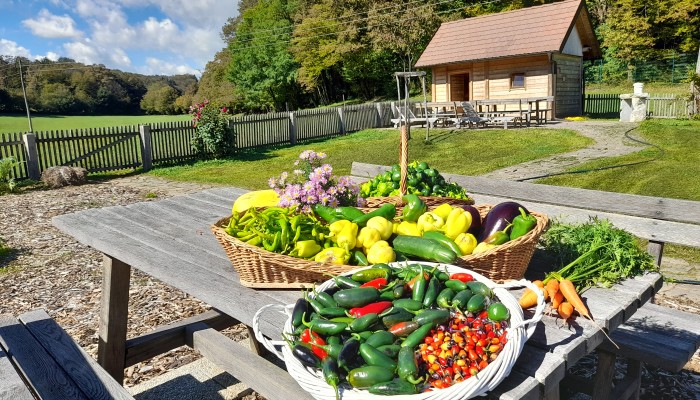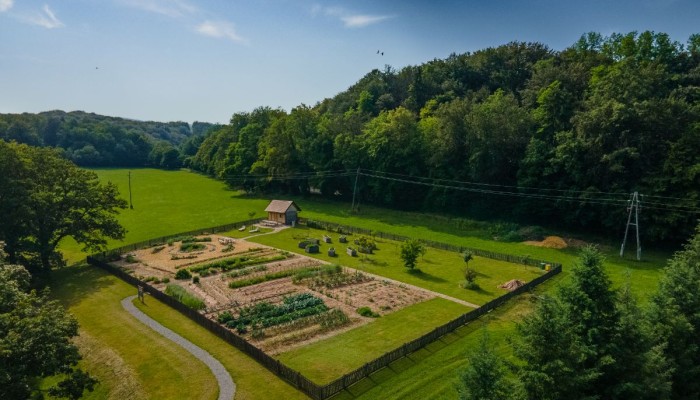Total price:
Autumn in the Organic Castle Garden
Fermenting Vegetables

In recent years, fermented foods have become true stars of healthy eating – and for good reason. Yogurt and kefir, sauerkraut and other homemade fermented vegetables, along with kimchi, kombucha, and miso, are not just passing trends. They are natural health allies, strongly endorsed by modern science.
That is why we at Terme Krka have begun fermenting some of the vegetables grown in our Castle Garden, ready to bring their benefits into our kitchens throughout the winter.

Fermentation not only extends the shelf life of food but also enhances its nutritional value and supports gut health. Including fermented foods in your daily diet is one of the simplest yet most powerful ways to improve long-term wellbeing.
By Janja Strašek and Jana Kovačič Petrovič
Why are fermented foods so beneficial?
-
They support a healthy gut
Fermented foods are natural probiotics, rich in beneficial bacteria that help maintain a balanced microbiome. This is vital for digestion, nutrient absorption, and immunity. Regular consumption can ease bloating, constipation, and other digestive issues.
2. They strengthen the immune system
Around 70% of our immune system resides in the gut. When gut flora is balanced, our body’s natural defences are stronger. As highlighted by Verywell Health, probiotics limit the spread of harmful bacteria, lowering the risk of infections, inflammation, and even autoimmune conditions.3. They aid metabolism
Fermented foods play a role in the metabolism of carbohydrates, fats, and proteins. According to the Cleveland Clinic, probiotic bacteria may help reduce blood sugar levels by improving insulin sensitivity – particularly valuable for people with prediabetes or type 2 diabetes.4. They support mental wellbeing
The gut–brain connection is well established. Fermented foods may help ease symptoms of anxiety, stress, and depression. Research from Johns Hopkins Medicine shows that microbiome composition influences the production of neurotransmitters such as serotonin and dopamine.5. They help manage body weight
A healthy gut means better appetite control, more efficient metabolism, and reduced inflammation. TheHealthy notes that fermented foods can help reduce abdominal fat by influencing hormones that regulate satiety.6. They improve nutrient absorption
Fermentation breaks down antinutrients such as phytates, which otherwise block the absorption of iron, zinc, and magnesium. Studies from the Mayo Clinic confirm that fermenting food increases the bioavailability of essential vitamins and minerals, enhancing overall nutrition.7. They protect against harmful microbes
Probiotic bacteria in fermented foods compete with pathogens in the gut, suppressing their growth. As WebMD reports, regular consumption lowers the risk of foodborne illness and infections linked to gut flora imbalance.
Fermentation – Nature’s Way of Enriching Food
Fermented foods are also considered functional foods – foods that actively support health. They are not medicines, but when consumed in the right amounts, they can have preventive and restorative effects, helping to ward off illness or slow its progression.
Functional foods may include organically grown produce, already a treasure we have at hand, but they become even more valuable when enhanced through special processing. This may mean sprouting, fermenting, or even simply soaking them to reduce phytates and saponins – natural compounds that bind to vitamins and minerals, preventing their absorption. Fermentation activates food biologically, allowing nature to work its magic and unlocking the greatest possible nutritional benefits.

Fermentation itself is a completely natural, microorganism-level process that is now well understood. The Food and Agriculture Organization of the United Nations (FAO) defines it as the slow breakdown of organic matter caused by microorganisms or complex nitrogenous substances (enzymes) of plant or animal origin. By fermenting basic foods, we add true value: food is enriched with a wealth of beneficial microorganisms, nourishing the body from within.
Fermented foods are rich in lactic acid bacteria, a key component of a healthy gut microbiome – and a balanced microbiome is essential for vitality. This is why fermentation is also known as biological preservation or natural preservation. Not only does it extend the life of food, but it can even enhance its nutritional value.


Castle Garden at Otočec
The Castle Garden is located near Otočec Castle, in a pure and unspoiled environment.
Dobri, vsem poznani fermentirani živili sta:
-
Sauerkraut
a true treasure trove of health:
- Rich in vitamins, especially vitamin C, as well as minerals, trace elements, and fibre
- Supports regular bowel movements and cleansing, thereby improving metabolism; a balanced gut flora allows nutrients to be absorbed more easily, strengthening the immune system
- Helps prevent common health issues such as winter colds, anaemia, skin problems, and excess weight, while also easing digestive difficulties
Because of its exceptional benefits, sauerkraut is best enjoyed raw, as cooking reduces some of its nutritional and restorative properties.
-
Pickled Turnips
a hearty, nourishing food:
- Supply the body with essential fibre, protein, and carbohydrates
A rich source of calcium, sodium, potassium, magnesium, iron, and phosphorus, along with vitamins B1, B2, B3, and C - Contain folic acid and antioxidants that slow the ageing process
- Rich in glucosinolates, sulphur-containing compounds that benefit the respiratory and circulatory systems; their vitamin K content also supports cleansing and blood health
- Offer antiseptic effects, help cleanse the urinary tract, stimulate glandular function, boost metabolism, regulate digestion, and may protect the colon by inhibiting carcinogenic processes
Pickled turnips can be eaten raw, though their sharp flavour means they are more often enjoyed cooked in winter stews and soups. Still, raw pickled turnip can be a refreshing addition to winter salads – and even makes a surprisingly tasty sandwich filling.
- Supply the body with essential fibre, protein, and carbohydrates
Wet Fermentation – Preserving Vegetables and Even Fruit
Wet fermentation uses brine and is ideal for larger pieces of vegetables – such as cauliflower, carrots, pumpkin, or broccoli – and even cherry tomatoes, shallots, garlic cloves, and cucumbers.

How to ferment with brine
Begin by preparing the brine.
For most vegetables, use a 2% brine solution (20 g of salt per litre of water). For watery vegetables such as cucumbers, courgettes, and tomatoes, a stronger 3.5% brine is needed (35 g of salt per litre of water). Simply stir the salt into cold water until fully dissolved.
- Wash the vegetables and cut them into pieces, depending on the type of vegetable and your preference.
- Add spices to taste.
- Place the vegetables into a glass container, pressing them down firmly to remove any air bubbles.
- Place a weight on top of the vegetables and pour over the brine so that everything is fully submerged. No piece of vegetable should float above the liquid.
- Fit a fermentation lid onto the container and secure it with a screw band. Leave to ferment at room temperature.
- Taste softer vegetables after about five days, and harder ones after ten to fourteen days. If the acidity is to your liking, remove the weight, replace the fermentation lid with a tight-fitting cover, and store in a cool place (a pantry, cellar, or refrigerator). If the flavour is not yet right, leave to ferment for another day or two.
Vegetable Fermentation Recipes
Fermented Carrots with Ginger
Ingredients for approximately two 1-litre jars
- 1 kg carrots
- 1 clove garlic
- 5 cm piece of ginger root, about 1 cm thick
- 2% brine
- optional: 1 small fresh chilli or ¼ teaspoon chilli flakes
Wash the carrots and cut into sticks. Slice the ginger thinly. Peel the garlic and place it at the bottom of the jar together with the chilli flakes or fresh chilli slices. Pack the carrots and ginger tightly in layers up to the neck of the jar, then pour over the brine.
Ferment at room temperature for about 14 days.

Fermented Shallots
Ingredients for one 0.7–1 litre jar
- 250 g shallots
- 1–2 bay leaves
- 1 teaspoon black peppercorns
- 2% brine
Peel the shallots. Place the bay leaves and peppercorns in the jar, then add the shallots and cover completely with brine.
Leave to ferment at room temperature for about 10 days, then store in the refrigerator.

Fermented Mixed Vegetables
Ingredients for approximately two 1-litre jars
- 1 small cauliflower
- 1 red pepper
- 2 large carrots
- 2 celery stalks
- a handful of shallots or small onions
- 4 cloves garlic
- 2 bay leaves
- 1 teaspoon black peppercorns
- 2% brine
- optional: 1 small fresh chilli or ¼ teaspoon chilli flakes
Wash the vegetables and cut into larger pieces. Place the bay leaves and peppercorns at the bottom of the jar, then layer in the vegetables, pressing down firmly. Pour over the brine, weigh down with a glass weight, and ensure the vegetables are fully submerged.
Leave in a dark place at room temperature for 10–14 days, then taste to check the flavour.

Fermented Cherry Tomatoes with Basil
Ingredients for one 1-litre jar
- 500 g cherry tomatoes
- 1 handful fresh basil leaves
- ½ onion, sliced into rings
- 3.5% brine
- optional: a few sprigs of thyme
Place the onion rings and basil leaves at the bottom of the jar. Wash the tomatoes, pierce each three to four times with a toothpick, and pack them tightly into the jar. Weigh down with a glass weight and pour over the brine.
Ferment for about five days. In summer or at higher temperatures, three days may be enough. Taste and, if the tomatoes are not sour enough, leave for another day or two.
How to Enjoy Fermented Vegetables
Fermented vegetables are perfect as a side dish with both hot and cold meals made from meat, eggs, or cheese. They can also add flavour and nutrition to wraps, stews, and vegetable soups – or simply bring a refreshing twist to salads and sandwiches.







